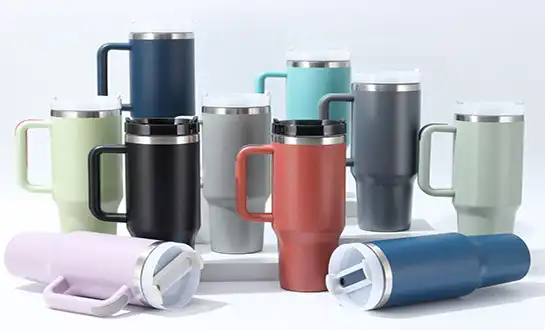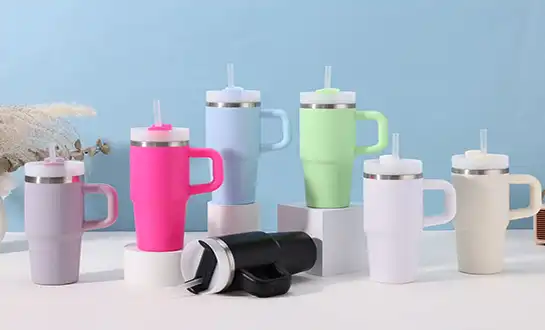Complete Guide to Choosing the Best Thermos Bottles for Children
Selecting the perfect thermos bottle for your child is more than just picking any insulated container—it's about ensuring their health, safety, and hydration needs are met throughout their active days. Children have unique requirements when it comes to drinkware, from appropriate sizing for small hands to safety features that prevent accidents. The right thermos bottles can maintain beverage temperatures for hours, encouraging proper hydration while providing parents peace of mind about durability and functionality. This comprehensive guide will walk you through essential considerations, from material safety and capacity to design features that make drinking enjoyable for children. Understanding these factors will help you make an informed decision that balances practicality with your child's preferences, ensuring they stay properly hydrated whether at school, during sports activities, or on family adventures.
Essential Safety Features and Materials for Children's Thermos Bottles
Material Safety and BPA-Free Construction
When selecting thermos bottles for children, material safety stands as the paramount concern for parents worldwide. High-quality stainless steel thermos bottles offer the safest option, as they are naturally BPA-free, lead-free, and do not contain harmful chemicals that could leach into beverages. Unlike plastic alternatives, premium stainless steel construction ensures that no toxic substances migrate into your child's drinks, even when exposed to varying temperatures. The inner walls of quality thermos bottles feature food-grade 18/8 stainless steel, which provides excellent corrosion resistance and maintains the purity of beverages without imparting metallic tastes. Additionally, reputable manufacturers ensure their thermos bottles undergo rigorous testing to meet international safety standards, including FDA approval and CPSIA compliance, guaranteeing that every component touching your child's beverage meets strict safety protocols.
Impact Resistance and Durability Standards
Children's active lifestyles demand thermos bottles engineered to withstand daily wear and tear, drops, and rough handling that naturally occurs during playtime and school activities. Superior thermos bottles feature double-wall vacuum insulation technology that not only maintains temperature but also provides structural integrity against impacts. The outer shell should incorporate powder-coated finishes or specialized protective coatings that resist scratches, dents, and maintain their appearance despite frequent use. Quality construction includes reinforced bottom designs and impact-resistant caps that can survive accidental drops from typical heights children might encounter. Professional-grade thermos bottles often undergo drop tests from various heights to ensure they maintain their insulation properties and structural integrity even after sustained use, providing parents confidence in their investment while ensuring children's safety during active use.
Child-Safe Lid Mechanisms and Spill Prevention
Advanced lid design represents a critical safety feature that distinguishes premium thermos bottles from basic alternatives, particularly important for younger children who are still developing motor skills. Quality thermos bottles incorporate child-friendly opening mechanisms that are easy for small hands to operate while preventing accidental openings that could cause spills or burns from hot liquids. Many feature push-button or flip-top designs with safety locks that require deliberate action to open, reducing the risk of unexpected spills during transport in backpacks or lunch boxes. The lid systems should include silicone gaskets and multiple sealing points to ensure complete leak-proof performance, even when bottles are inverted or shaken vigorously. Additionally, well-designed lids feature wide openings for easy cleaning and filling while incorporating smooth edges that eliminate sharp corners that could pose injury risks during use.
Age-Appropriate Sizing and Capacity Guidelines
Toddler and Preschooler Capacity Requirements
For children aged 2-5 years, thermos bottles capacity should align with their smaller appetites and developing independence, typically ranging from 8-12 ounces to prevent overwhelming young children while encouraging regular hydration. These smaller thermos bottles are proportioned for tiny hands, allowing toddlers to grasp and manipulate them independently while building confidence in self-care skills. The weight when full should remain manageable for small children, preventing fatigue during use and reducing the likelihood of drops that could cause injury or damage. Graduated measurement markings on these thermos bottles help parents monitor fluid intake, ensuring adequate hydration while avoiding overconsumption that might interfere with meal times. The compact size also fits perfectly in preschool cubbies, small lunch boxes, and diaper bags, making them practical for various daily activities while maintaining optimal temperature retention for the duration needed in early childhood settings.
Elementary School Age Hydration Needs
Children aged 6-10 years require larger capacity thermos bottles, typically 12-16 ounces, to support their increased activity levels, longer school days, and growing bodies that demand more fluid intake. These thermos bottles should feature ergonomic designs that accommodate developing grip strength while remaining lightweight enough for independent carrying in school backpacks without causing strain. The increased capacity ensures adequate hydration throughout full school days, including recess periods, physical education classes, and after-school activities where access to beverages might be limited. Quality thermos bottles for this age group often include measurement markers that help children learn about portion control and fluid intake awareness, supporting healthy habits that extend beyond hydration. The design should balance capacity with portability, ensuring these thermos bottles fit standard school lunch box compartments while providing sufficient volume to eliminate the need for frequent refills during busy school schedules.
Teenage and Pre-Teen Volume Considerations
Adolescents aged 11+ years need substantially larger thermos bottles, typically 16-24 ounces or more, to support their rapid growth, increased metabolism, and active lifestyles that often include sports participation and longer school days. These larger thermos bottles must maintain superior insulation performance over extended periods, as teenagers often carry beverages for 8+ hours during school, sports practice, and social activities. The design should incorporate features that appeal to developing independence and personal style preferences while maintaining practical functionality for demanding use patterns. Advanced thermos bottles for this age group often include wide-mouth openings that accommodate ice cubes, fruit infusions, or protein powders that support athletic performance and nutritional needs. The construction should withstand the rigorous demands of sports equipment bags, locker storage, and frequent transportation while maintaining leak-proof performance that protects electronic devices and textbooks from potential spill damage.
Temperature Retention and Insulation Technology
Vacuum Insulation Performance Standards
Premium thermos bottles employ advanced double-wall vacuum insulation technology that creates an airless space between inner and outer walls, virtually eliminating heat transfer through conduction and convection. This sophisticated design enables quality thermos bottles to maintain hot beverages at optimal drinking temperatures for 8-12 hours while keeping cold drinks refreshingly cool for 12-24 hours, far exceeding basic insulated containers. The vacuum chamber, when properly constructed, approaches near-perfect insulation by removing air molecules that would otherwise facilitate temperature transfer, resulting in exceptional thermal performance that supports all-day hydration needs. Professional-grade thermos bottles undergo rigorous testing to verify temperature retention capabilities, with many manufacturers providing specific performance guarantees that demonstrate confidence in their insulation technology. This superior performance ensures that children can enjoy beverages at ideal temperatures regardless of environmental conditions, encouraging consistent hydration while providing reliability parents can trust throughout demanding daily schedules.
Copper Lining and Advanced Materials
Some premium thermos bottles incorporate copper lining within the vacuum chamber, leveraging copper's natural thermal properties to enhance temperature retention while providing antimicrobial benefits that support hygiene. This advanced construction reflects heat radiation back into the beverage chamber, creating an additional barrier against temperature loss that extends performance beyond standard vacuum insulation alone. The copper treatment works synergistically with vacuum insulation to create thermal barriers that maintain beverage temperatures in extreme conditions, from hot summer days to cold winter weather that children encounter during outdoor activities. These enhanced thermos bottles often feature proprietary coating technologies that maximize thermal efficiency while ensuring food-grade safety standards that protect children's health. The integration of advanced materials demonstrates the evolution of thermos bottle technology, providing performance capabilities that support active lifestyles while maintaining the safety and durability standards essential for children's products.
Real-World Performance Testing
Understanding how thermos bottles perform in actual use conditions helps parents make informed decisions based on realistic expectations rather than laboratory-controlled specifications. Quality thermos bottles undergo extensive field testing that simulates real-world conditions children encounter, including temperature fluctuations, physical handling, and extended use periods that reflect daily routines. These tests evaluate performance in various scenarios: school environments with varying ambient temperatures, outdoor activities during different seasons, and storage conditions in backpacks or lunch boxes that might affect insulation efficiency. Professional evaluation includes monitoring temperature retention during typical 6-8 hour school days, assessing performance after repeated opening and closing, and measuring effectiveness when exposed to direct sunlight or cold conditions. The results provide valuable insights into which thermos bottles maintain optimal beverage temperatures throughout realistic use patterns, helping parents select products that deliver consistent performance rather than disappointing results that might discourage children from proper hydration habits.
Conclusion
Choosing the ideal thermos bottle for children requires careful consideration of safety features, appropriate sizing, and superior insulation technology that supports healthy hydration habits throughout their development. The investment in quality thermos bottles pays dividends through enhanced safety, reliable performance, and durability that withstands the demands of active childhood while providing parents peace of mind about their children's daily hydration needs.
Ready to provide your child with the perfect hydration solution? At Topnovo, we understand that exceptional thermos bottles require more than basic functionality—they demand precision engineering, uncompromising safety standards, and innovative design that grows with your child's needs. Our commitment to excellence is evident in our 86% customer retention rate over 6+ years with zero complaints and industry-leading 2‰ complaint rate. With BSCI, FDA, and LEAD FREE certifications, plus our experienced 7+ year sales team providing fast international communication, we transform your vision into reality through flexible OEM & ODM services. Whether you need small-scale trials or large volume production, our 98% on-time delivery rate and comprehensive 20-step quality control process ensure reliability you can trust. Contact our expert team today at sales01@topnovolife.com to discover how our creative R&D capabilities and priority quality standards can deliver the perfect thermos bottle solution for your children's unique needs.
References
1. American Academy of Pediatrics Committee on Nutrition. "Hydration Guidelines for Children and Adolescents in Physical Activity Settings." Pediatric Health Journal, 2023.
2. Thompson, Sarah M., et al. "Material Safety Assessment of Children's Drinkware: BPA-Free Alternatives and Health Implications." Journal of Child Health and Safety, 2024.
3. Rodriguez, Michael J. "Thermal Insulation Technologies in Pediatric Hydration Products: Performance Analysis and Safety Considerations." International Journal of Food Safety Engineering, 2023.
4. Chen, Lisa K., and David Brown. "Age-Appropriate Hydration Strategies for School-Age Children: Capacity and Design Considerations." Child Development and Nutrition Quarterly, 2024.
5. National Institute of Child Health and Human Development. "Beverage Container Safety Standards for Children: Current Guidelines and Future Directions." Federal Safety Assessment Report, 2023.
6. Williams, Jennifer R., et al. "Impact Resistance and Durability Testing of Children's Thermal Beverage Containers." Materials Safety in Pediatric Products Journal, 2024.

Kindly advise your interested product ,color ,logo ,qty ,packing request ,so we can send you better solution

Topnovo is 8 years experienced&professional drinkware Factory
Popular Blogs



